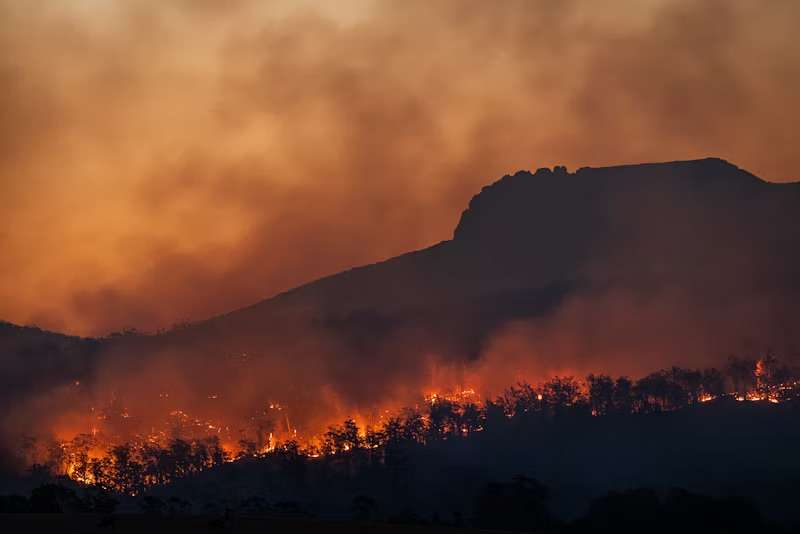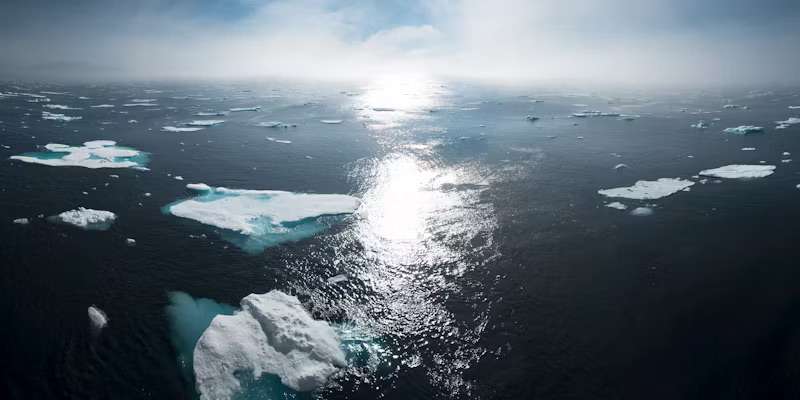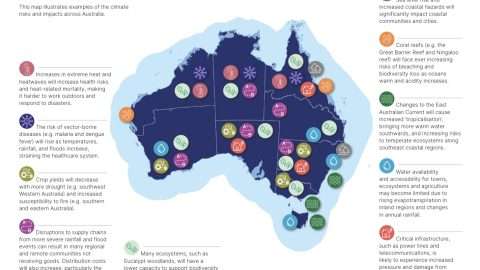May I begin by acknowledging the traditional owners of this land that we’re gathered on tonight, the Gadigal people. I pay my respects to their leaders, past and present, and note the vital role this museum is playing to remind us that care for Country matters more than ever.

It’s a tremendous honour to present this year’s Talbot Oration, the first since Professor Frank Talbot’s passing last October.
Like Frank, though, I do want to focus on climate change – and even galvanise a bit of action. Scientists have long warned us that, by pumping out more greenhouse gas, we will heat up the planet. We can expect a more erratic climate with worsening weather extremes until we stabilise the concentration of carbon dioxide, methane and those other heat-trapping gases.
It’s not like we haven’t seen this problem coming. Scientists described the greenhouse effect in 1824 – two full centuries ago, and just three years before the Australian Museum’s foundation. I’ll argue it’s definitely in our interest to take bold climate action, and not just because Australia is among the most vulnerable to wilder weather. If we can rise to this necessary challenge of exiting fossil fuels, we can aid other nations’ transitions too.
New engines of prosperity are up for grabs and we should grab them. We can’t afford to wait.
As climate scientist Joelle Gergis told us in her Quarterly Essay last year: “we are the last generation that will experience the world as we know it today… The last to experience the tropical wonders of the Great Barrier Reef, summers uninterrupted by life-threatening storms, and the awe of wild places before they succumb irrevocably to the ravages of fire and intolerable heat”.
You may have heard that last month’s record flooding around Taree on this state’s mid-north coast was a one-in-500-year event. Once statistically rare, these events are now occurring with concerning regularity. So far this year, we’ve also endured huge floods in northern and western Queensland, while Cyclone Alfred veered much further south than most tropical tempests, leaving big power outages and another burst of floods.

Federal Treasury put the immediate cost to the economy of these four events at $2.2 billion.
Of course, Australia is hardly alone when it comes to a shifting climate.

The world set a global annual heat record in 2023 only for 2024 to break it. This year won’t be far off, either. In decades to come, we’ll probably look back at this trio of years as mercifully cool. In the past week, you may have seen the collapse of a Swiss alpine glacier amid a record spring heatwave in Europe, or the huge wildfires raging across Canada. On the Arctic Circle, we’ve had 30-degree days. In Siberia, minimum temperatures have smashed previous records by 10 degrees – all at the end of Spring.
The World Meteorological Organization told us last month there is an 80 – eight-zero – percent chance that at least one of the years from 2025 to 2029 will beat the 2024 heat record. The WMO also estimates there is a 70 percent chance the average temperature over the coming five years will exceed 1.5 degrees above the 1850-1900 baseline – a clear sign of persistent warming.
To be clear, the Paris climate agreement – that we and almost 200 nations signed up to – pledged to keep global warming to well below 2 degrees and under 1.5 degrees if possible. Those Paris markers refer to long-term warming levels, typically exceeding 20 years. That means we still have time to arrest this direction of travel to a hothouse destination that we don’t want to reach.

So, what are we going to do about it?
As the Dutch writer, Rutger Bregman wrote in his new book, Moral Ambition, Martin Luther King Junior didn’t rally Americans with “I have a nightmare!” Rather, he laid out his dream – and so should we.
First, we should ignore the doubters whose main mission seems to be to prolong the life of fossil fuel industries.
Opponents of climate action don’t give up even when their political parties cop an electoral hammering. To those politicians who are still providing a cover for vested interests, I say get out of the way. Stop holding our country back and stop holding your political parties back. Try acting in the national interest – or take the low road to political oblivion.
We can expect climate action opponents to query the economics now they’ve lost the argument over physics and chemistry. “It’s not a scientific denial,” Andre Correa do Lago, the Brazilian diplomat who will head this year’s UN climate summit in the Amazon warned last week. “It’s an economic denial.” He stressed that the measures needed to combat climate change can be good for the economy and people. It’s a view that might run in his family.
Corrêa do Lago, it turns out, is the youngest of five brothers, all of whom became economists. “My mother was horrified with our lack of originality,” he joked to the Guardian.
As you may know, Australia is in a two-horse race to follow Brazil and host next year’s climate summit late next year. That would be COP31, or the 31st Conference of the Parties, as these gatherings are known. Wouldn’t it be great if COP31 turned out to be the last we ever needed? That’s probably getting a bit too dreamy – let’s secure the hosting rights for Adelaide first.

Still, if we become the COP hosts along with our Pacific partners, we can expect climate matters to occupy an even more prominent place in our political discourse for a year at least. So how might we make the most of this opportunity to accelerate action where it’s already underway and to kickstart it where it’s not?
As a former energy minister in NSW in a Liberal government, I saw an opening to reach out to political opponents to help quell the climate wars in this state. It can be done even if some of those inclined against climate policy reside on your own side of the chamber. Hunt hard enough for common interest, though, and you can find it. It helps that the economics are also aligning with the science. As US energy innovator Hal Harvey put it: “It’s now cheaper to save the Earth than to ruin it”.
Investors are lining up trillions of investment dollars to decarbonise economies. Even so, we must be realistic about the scale of the task ahead. Some have likened the challenge ahead to Franklin Roosevelt’s transformation of the US economy to defeat Germany and Japan in World War 2 (Australia didn’t shirk its international obligations then, either).
Progress has not been fast enough. Global carbon emissions are still rising. Recent good news is that China, by far the world’s largest polluter, may have reached peak emissions in the past few months. It’s early days yet but the slowdown in emissions appears to be caused by China’s rapid advance of renewable sources of electricity – not an economic slowdown. Despite US President Donald Trump’s embrace of coal in his first term or his promise to “drill, baby, drill” in his second, fossil fuels are increasingly eclipsed by renewables globally when it comes to luring new investment.
We’ll need a lot more.

Earlier this year, Michael Cembalast, a respected energy analyst for US Bank, JPMorgan, estimated the global spend on new wind, solar, batteries, electric vehicles and other clean tech over the past decade amounts to some US $9 trillion (or about AUD $15 trillion). To be clear, some of that money would have gone on replacing clapped-out coal plants or other equipment whose use-by date had passed. Even so, renewables’ share of final energy consumption has only been advancing between 0.3 and 0.6 percentage points per year.
Where should we look for optimism? Try upwards.
Bell Labs in the US made the first solar cell in 1954. It took a young Australian researcher, Martin Green – toiling away in the early 1970s at the University of NSW – to develop a solar cell capable of mass production. Since then, the cost of solar panels has dropped by about 99 percent. That’s partly because graduates supervised by Professor Green unleashed a huge expansion of solar production in China and elsewhere. Price per unit has steadily dropped by about a fifth every time output doubled.
Martin Green should be a household name – particularly among the 4 million or so Australian houses that have solar panels. That’s better than one-in-three houses, a world-leading share. This museum is doing its bit, including Martin’s work in an exhibition that can be viewed as a virtual tour online. You’ll be able to zoom in on his donation of an early prototype high-efficiency solar cell.
Solar and wind energy will be key to our success in halting climate action. As Bloomberg noted last month, renewable energy now makes up over 90% of annual new additions to the global power system each year. And there’s more to be wrung out of these renewables – costs may halve yet again by 2035 alone, Bloomberg estimates. And you can be sure Martin will be among those extending the frontiers of knowledge.
Nuclear, we can say, is playing a role globally. But note: in 2019, reactors produced five times the total amount of power as solar panels. Now, the two sources are roughly equal, according to Ember, an energy think tank. One of those two technologies promises falling prices while nuclear cost blowouts are the norm.
Solar’s emerging partner, of course, is storage, whether made from lithium or an emerging raft of materials.
Battery prices dropped by about a third last year and costs should keep sinking as innovation combines with scale. Perhaps we should dub these twins, “the charge and the light brigade”.
Now, you may know that the Climate Change Authority, of which I’m the Chair, is the nation’s source of independent climate advice. We are presently preparing to advise the government on what Australia’s 2035 target should be. I have said previously that I want a target that’s ambitious, informed by the science but also achievable. Part of our work is to understand what Trump’s efforts to dismantle the Biden Administration’s decarbonisation funding mean for our own – will they hamper or help us?
Some political or business leaders have suggested if a target appears beyond reach, we should throw in the towel. In fact, there are many ways we can do more, mostly by going with the electron flow. The pace of electrification will determine whether we succeed.
Take electric vehicles. Globally, EVs will account for about a quarter of sales globally this year, up from a fifth in 2024, according to the International Energy Agency. By 2030, EVs’ share may rise to 40% or beyond. Australia has been a bit slow out of the blocks, but our pace should quicken along with the roll-out of fast-chargers (China had 3.2 million public charge points as of last July). More Australian EV owners are recharging their cars off their own solar – free riders of a worthy kind. In the future, many will also support the power sector by discharging power once vehicle-to-grid capability becomes common.
These so-called distributed energy resources of solar and batteries actually offer power to the people – an outcome the party of Robert Menzies has always believed in. Any fair dinkum liberals and conservatives should advocate for such policies today. Indeed, giving households more help to take up solar and batteries is not only good politics. It could pick up some of the slack if the larger grid overhaul takes longer than expected.
Some of the handbrake on large-scale renewables is easing but challenges like clogged supply chains, slow approvals and social license issues persist.
Dr Gabrielle Kuiper, a distinguished expert on distributed energy resources, sees opportunities for homes and smaller businesses to help the government meet its 2030 goal of sourcing 82% of power from renewables as part of its legislated emissions reduction goal. Gabrielle estimates the grid is on track to fall shy of that target by the equivalent of about 10 gigawatts’ worth of large-scale solar farms. Given we need to add about 6GW a year of solar or wind farms to 2030, such a projected shortfall is sizeable.
There’s also a looming home and business storage gap of about 4 gigawatts versus the Integrated System Plan modelled by the market operator, according to Dylan McConnell, an energy expert at the University of NSW.
Fortunately, there are ways to respond and some of them will soon ramp up.
Well, the government’s new multi-year battery subsidy program will likely be very popular.
Early indicators suggest the take-up may reach 1 million households – versus the 75,000 batteries installed in homes in 2024.
Likewise, gaze out the window next time you take off from a city airport. See how many factory, warehouse or shopping centre rooftops appear ripe for solar.

Bruce Mountain, head of the Victoria Energy Policy Centre, estimates his state’s commercial and industrial rooftops could generate 56 terawatt-hours of electricity a year. That’s more than Victoria’s total end-use power demand. But, so far, firms have tapped just 7% of the opportunity.
We can unlock this potential by removing unnecessary charges or rules that get in the way. Similarly, we can devise ways that owners and tenants share the spoils. We should also encourage developers to build panel-ready new structures – both for factories and homes. Governments should also insist on better energy efficiency outcomes for newly built homes, so we don’t lumber their owners with decades of energy waste and bigger bills.
The same goes for appliances – why should Australians accept poorly performing devices, whether locally sourced or imported? While we cherish free markets and the role of private capital, we have to be realistic: decarbonisation is not just going to happen, we have to help it to happen. That means governments setting ambitious goals and targeting big emitting industries with judiciously granted support to achieve them. Think steel, cement and even farming.
The Superpower Institute – led by eminent Australians Ross Garnaut and Rod Sims – has spelt out how green steel and iron, and other new minerals offer our workers and industries new avenues for exports and growth.
Our fossil fuel exports – plus what we burn at home – make Australia a significant overall emitter, accounting for about 4.5 per cent of the global total. By developing new green industries, powered by our abundant sunshine and wind, we can help the world decarbonise perhaps twice that share, or 9.6%.
So, we shouldn’t shy from this battle especially when we can win.
Imagine if the early abolitionists had given up their fight against slavery, or the suffragettes had accepted women didn’t deserve the right to vote? Both groups took heart from small initial wins and regrouped after setbacks.
They also sought allies in unlikely places to ensure their movements of change gathered momentum until they became irresistible.
Bregman, whom I mentioned before, noted support within the British Parliament for an end to slavery got its biggest boost by highlighting how British sailors on the slave ships were dying at a greater rate than slaves. A parallel in today’s battle might be that governments must ensure communities that will inevitably be weaned off fossil fuels are given every opportunity to share the new prosperity.
To conclude, great institutions like the Australian Museum have long fostered an awe of nature but have also celebrated human endeavour and innovation. Their dedicated staff deserve our appreciation. These places reveal how much science matters. And we’re going to need a lot more of it whether basic or applied in the coming decades.
After all, our challenge is not just figuring out how to cut emissions but also how we’re going to cope with the climate consequences already in train.
So, we have our work cut out. But so did those trying to land somebody on the moon, or devise on the fly, a vaccine for COVID-19. The advances in the technologies we need – like solar, wind and batteries – are amazing.
Other breakthroughs will no doubt emerge. Machines that can learn and quantum computing capabilities could also be decisive allies. We should be optimistic – but resolute and tireless too. A key message to leave you with tonight is that we can’t afford to fail.
Not if we want to have a Great Barrier Reef that is still great, with brilliant, iridescent corals and those “giant aquariums of gorgeous fishes”.
Not if we want to live in safe, comfortable homes, spared from the worst of floods, cyclones and bushfires.
Not if we want to avoid filling our museum collections with extinct species that we could have and should have saved.
At stake, after all, is whether we really do leave our planet to our children and their children better than we found it – as Frank Talbot strived to do. That way, when my Tom and Zoe and other kids peer up in wonder into the cabinets continuing natural gifts, they’ll see species that are not extinct but rather, remain wild and free.
We will have succeeded because we knew the dangers – and we acted.
~~~~~~~~~~~~~~~~~~~~~~~~~~~~~~~~~~~~~~~~~~~
* If you’d like to COMMENT on this or any of our stories, don’t hesitate to email our Editor.
** WHILE YOU’RE HERE –
PLEASE HELP US TO GROW FREMANTLE SHIPPING NEWS
FSN is a reader-supported, volunteer-assisted online magazine all about Fremantle. Thanks for helping to keep FSN keeping on!
*** Don’t forget to SUBSCRIBE to receive your free copy of The Weekly Edition of the Shipping News each Friday!







